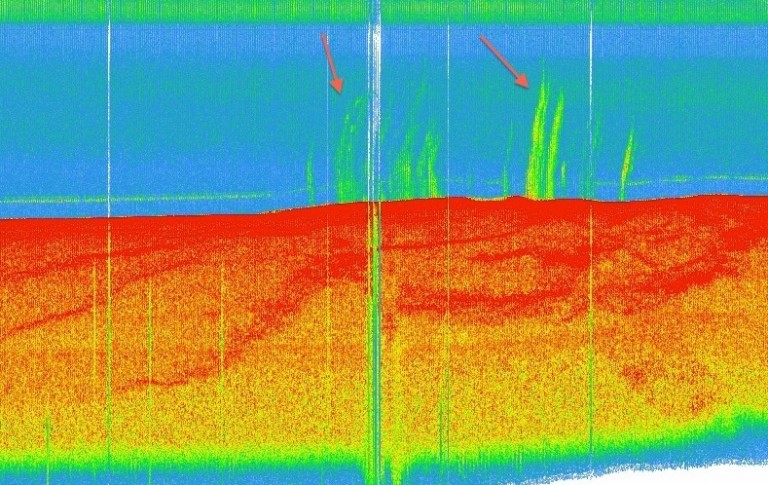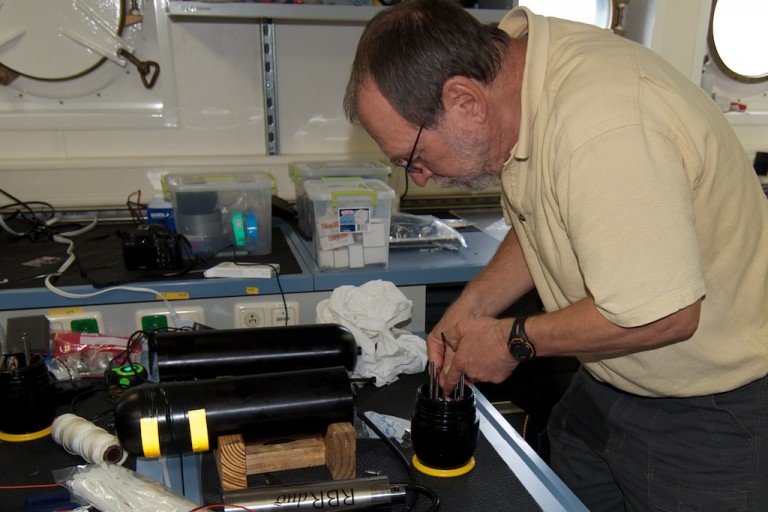Today we had both successes and setbacks. Working at sea is often like this.
As Ian MacDonald says, “When you do challenging science at sea, it is certain that sometimes things won’t work the way you planned. The weather will go bad; equipment will fail; the crucial instrument will have accidentally been left in the lab. What I find very satisfying about science at sea is overcoming these obstacles with only the people and parts you have at hand on the ship. Very often it comes down to nuts and bolts, so to speak: making something work or taking advantage of some special skill one of your shipmates happens to have.”

The successes were exciting….
Our intensive seafloor mapping efforts over the past days have revealed detailed imagery of hydrocarbon plumes bubbling up to the surface from 1,600 meters below. One region was especially dramatic, looking almost volcano-like on the sonar images. The plumes were named “Megaplume” and “Birthday Candles” in honor of Ian’s birthday. It was a very good birthday present for the Chief Scientist.
The seeps are so prolific that we saw oil bubbles come up to the surface just observing from the fantail of the ship. The bubbles ranged in size from small saucers to dinner plates. When they first emerged from below, the centers were a vibrant rainbow that then dispersed in the breaking waves. We recorded some pictures and video but then had to go inside when the weather picked up.

The setbacks were educational…
Although it was too rough to dive the ROV, the seas appeared manageable for deploying the multicore. With a black line of clouds on the horizon announcing an approaching squall, the team readied the multicore and lowered it into the sea. Waves passing under the ship added tension to the wire as the ship heaved, but all monitoring systems suggested that the deployment went as expected. Unfortunately the cores were empty when the instrument returned to the ship. Was there something wrong with the triggering mechanism? Did it land on a layer of ice-like hydrates that couldn’t be penetrated? Did it even reach the bottom at all with the rolling waves? What could be done to help figure out the source of the problem?
Ian had an idea to mount the camera from his video time-lapse camera system onto the multicore to record the deployment and its arrival on the seafloor. Mounting the camera was no easy task but when it was done, the multicore was lowered over the stern again. All systems looked good but the instrument came back a second time without sediment. Ian removed the camera and offloaded the video to his laptop in the dry lab. The video showed clips of the multicore descending to and arriving at the seafloor, a brown, sediment-rich bottom with no discernible signs of hydrate. The cores appeared to press into the sediments but possibly didn’t have enough weights on the frame. Weights were then added for one final try as the wind and swells were increasing. The multicore came back empty. This time the video gave a clearer picture of what might be the cause. The researchers concluded that tension of the heaving ship on the instrument frame may have caused the core mechanism to fire in the water column. The weather continued to worsen forcing operations to cease once again. But the video information gave the science team valuable information that should help the next deployment be successful.
Unfortunately, the weather forecast suggests that we will have to wait another day for this opportunity. The captain closed off all the deck areas, secured the portholes, and readied the ship for another night of rough seas. The science team carried on with more mapping of the plume area to prepare for the next ROV dive.
